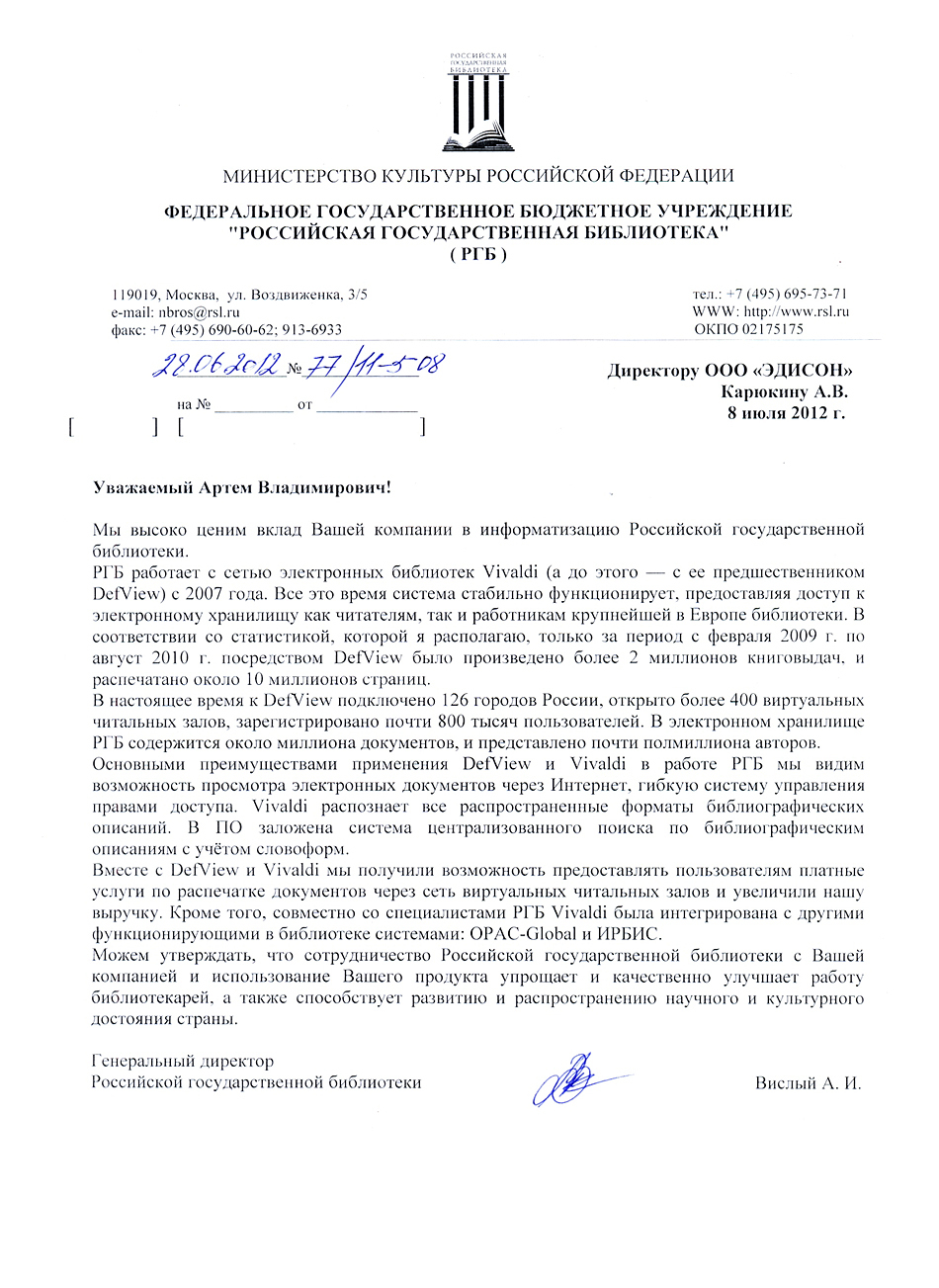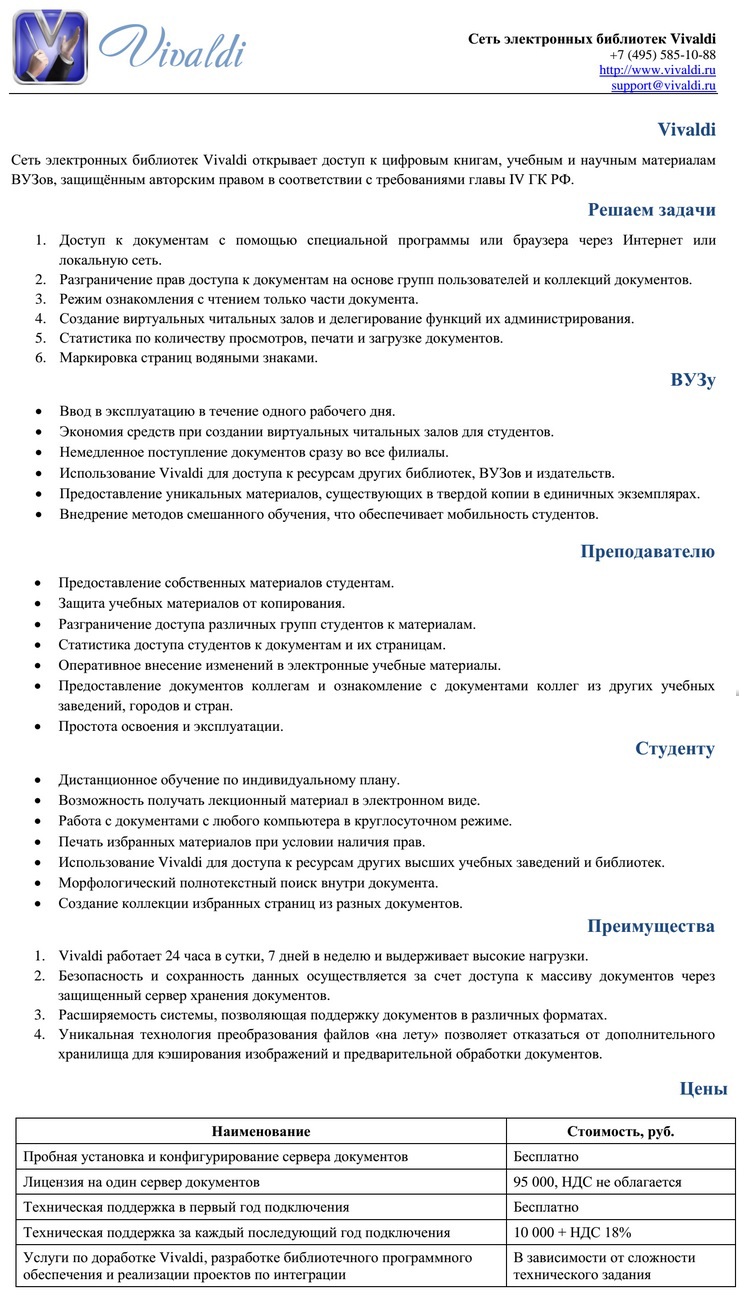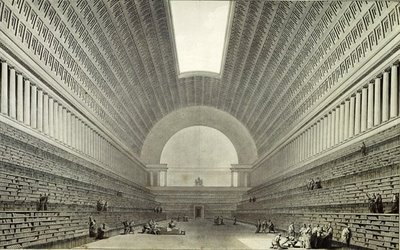Manage access to electronic documents. From DefView to Vivaldi
“When I was 19 years old I couldn’t go to college (I was from a poor family). We had no money, so I went to the library. Three days a week I read books. At the age of 27, I graduated from the library instead of university. ” - Ray Bradbury
“Better than 10 percent, but at home than 8 hours shaking on the train to sit for 4 hours in the VCHZ” , - a review of Defview on the forum . A virtual reading room, in this case, IT technology, which allows the user to have access to an electronic catalog containing 250,000 dissertations. 10% is the volume from the dissertation, which the system provides for a preview.
“Thank you so much for the opportunity to order books through the electronic catalog. This is really cool. ”, - quote from the video recording of the report “Strategic priorities of automation of the Russian National Library”. Thanks to the innovation, the user can remotely order a book from the book storage, after which he will be informed about the time the book was delivered to the library, which saves a lot of time.
 One Hundred Years of Solitude and Ugly Swans, I read from Moshkov’s library, Meganesia Corporation, and a bunch of If magazines from Librusek, Shchedrovitsky’s work from Cuba. Although I am a supporter of paper books, I still believe that digital libraries are an important part of the foundation of the information space.
One Hundred Years of Solitude and Ugly Swans, I read from Moshkov’s library, Meganesia Corporation, and a bunch of If magazines from Librusek, Shchedrovitsky’s work from Cuba. Although I am a supporter of paper books, I still believe that digital libraries are an important part of the foundation of the information space. The Deputy Director for Informatization of the Russian National Library in his speech states: “Libraries are very conservative.” Indeed, it took the Russian National Library 200 years to implement automation.
In fact, this year the library is 200 years old, and they have been developing an electronic access system since 2007.
In 2008, the law “On Amending Article 18 of the Federal Law“ On Librarianship ”” and the DefView project were issued, providing a secure viewing of documents, was very helpful.
Under the cut is a short description of the Vivaldi system and its predecessor - DefView, as well as the history of the development of electronic libraries from 1971 to the present day.
 The DefView system allows page-by-page viewing of a document, prevents unauthorized copying of text, provides a set of page operations (viewing, printing, loading), provides functions for previewing, scaling, rotating and inverting the colors of document pages, etc. However, in the process of its active use, it turned out that the implementation of other functions that the system was not designed for is important for users. Due to the fact that the DefView system was built as a monolithic solution, any refinement caused technical difficulties. In addition, with the increase in the number of clients, the number of data storage servers also increased, and it became increasingly difficult to control and manage them.
The DefView system allows page-by-page viewing of a document, prevents unauthorized copying of text, provides a set of page operations (viewing, printing, loading), provides functions for previewing, scaling, rotating and inverting the colors of document pages, etc. However, in the process of its active use, it turned out that the implementation of other functions that the system was not designed for is important for users. Due to the fact that the DefView system was built as a monolithic solution, any refinement caused technical difficulties. In addition, with the increase in the number of clients, the number of data storage servers also increased, and it became increasingly difficult to control and manage them. Therefore, in 2010, the Vivaldi.ru system was announced .
Project managers from Moscow and “Siberian responsible” engineers from Kemerovo and Tomsk ( Software Development Center ) worked on the product .
For good reason, the original name Vivaldi was chosen for the system. The great Italian composer Antonio Lucio Vivaldi was a very talented conductor - he skillfully managed a large joint orchestra, which included several small ones. So the Vivaldi system skillfully manages any number of servers and client applications, an array of digital documents of different libraries, without requiring any intervention from the side of administrators.
The Vivaldi structure is modular and consists of individual finished elements. Thanks to this approach, Vivaldi turned out to be flexible, it can be adapted to different customer needs. However, according to company policy, a full version of the system is always installed in all organizations, regardless of what functionality will be used in each case.
In the first few months, more copies of Vivaldi were sold than DefView in all the years of its existence.
about the project
Vivaldi.ru solves the following problems
· Providing access to documents from a client program or browser via the Internet or a local network.
· Full observance of copyright in accordance with Sec. IV Civil Code. Protect documents from uncontrolled copying.
· Differentiation of access rights to documents based on user groups and document collections.
· The mode of familiarization with reading only part of the document.
· Statistics on the number of views, printing and loading of documents and individual pages.
· Creation of virtual reading rooms and delegation of their administration functions.
· Marking pages with watermarks.
· Ability to refine the system.
· Full observance of copyright in accordance with Sec. IV Civil Code. Protect documents from uncontrolled copying.
· Differentiation of access rights to documents based on user groups and document collections.
· The mode of familiarization with reading only part of the document.
· Statistics on the number of views, printing and loading of documents and individual pages.
· Creation of virtual reading rooms and delegation of their administration functions.
· Marking pages with watermarks.
· Ability to refine the system.
Feedback from the Russian State Library about the project

There are a number of organizations that, for technical, financial or personnel reasons, cannot afford to purchase and maintain their own server for an electronic library. A new “cloud” service is available for them - renting space on the server of our company.
For content owners, full control over the use of documents has been preserved, under which you can set different levels of access to collections and individual texts, determine viewing quotas, print pages, receive detailed statistics for each reading room. Variations of orders have been developed: printing in color, printing in black and white, printing in A4, A3 format, electronic copying of individual pages of documents with a watermark, copying without a watermark, etc. Implemented the availability of financial transactions.
All organizations that use this system can be divided into three categories. The first is the institutions with which an agreement has already been concluded for the installation of software, it is configured and works effectively. The second is organizations that test the services and functionality of Vivaldi on their own servers. The management of these companies is at the stage of deciding whether to purchase or abandon the system, sometimes awaiting funding. The third category is libraries, publishers or universities that get acquainted with the system, not installing it on their equipment, but using the equipment of the Vivaldi project. It is difficult to say exactly how many servers are currently connected, because the system works automatically and there is no need to administer them - Vivaldi employees install and configure the server,
Vivaldi for business

Universities are actively creating electronic libraries and electronic library systems. Many of them have accumulated an array of their own methodological, educational and scientific literature in various disciplines. With Vivaldi, you can rationally organize access to all digital documents.
Providing students with digital copies of books, lectures, or lecture courses can solve the problem of their small circulation, and also makes it possible to track statistics on the use of individual books. At the same time, the guarantee is guaranteed that materials placed in the library system are protected from viewing by persons who are not authorized to do so.
Vivaldi for universities

International conference dedicated to the 200th anniversary of the opening of the Russian National Library. Report by Oleg Shorin “Strategic priorities for automation of the Russian National Library”:
In this video, the speaker addresses issues of consolidation, personal data, personnel policy, and solutions in the field of electronic document management. In the near future, it is planned to introduce pre-order books, geolocation, advisory and navigation services. Oleg Shorin touched upon the “telelift” system and RFID tags, which will increase the speed of book delivery by 8 times, and also spoke about the experience of using SemanticWeb technology and plans to create a single library ticket for all libraries.
“Finally, the Russian National Library has taken a step towards its readers. Such innovations are not only pleasing, but inspire hope that soon our libraries will be on a par with the leading libraries of the world. Many thanks to all those who participated in the implementation of this project , ”a review on the library website.
IT Transformation
Oleg Shorin talks about the work of the National Library of Russia (43 million storage units. The volume of electronic funds is 8 TB of information), about the problems of digitizing books and implementing automation systems. Describes: the advantage of information from the library over information from the Internet; how they process a large amount of information (more than 1000 works per day); about what is used from the BigData developments. The guest of the program said that soon everyone will have access to materials from regional encyclopedias, which before that were exclusively in print.
UNDER THE MANAGEMENT OF VIVALDI - article on the website of the Russian Association of Digital Libraries.

History of Digital Libraries
1971 - The Gutenberg Project became the first project to create an electronic library .
1990 - The Library of Congress launched the Memory of America project. The project provides free and free access to electronic materials on the history of the United States.
1994 - Moshkov Library .
2000 - Aldebaran .
2001 - Million Book Digital Library Project .
2002 - Google launches its own book digitization project. In December 2004, the launch of the Google Print library project was announced, which was renamed Google Books in 2005 .
2002 - Math.ru Library .
2003 -National Digital Library .
2007 - Librusek .
2007 - DefView document viewing system .
2008 - Federal Law of the Russian Federation of October 27, 2008 N 183-F3 “On Amending Article 18 of the Federal Law“ On Librarianship ”” .
2008 - the pan-European digital library Europeana began to function .
2009 - Opening of the World Digital Library.
2009 - The Presidential Library named after Boris Yeltsin was opened in St. Petersburg , the task of which is to provide electronic materials on the history of Russia.
2009 - Flibusta .
2010 - a network of electronic libraries "Vivaldi" .
More projects:
How to create software for the
SDK microtomograph for 5233 man-hours to implement support for e-books in the FB2 format
Managing access to electronic documents. From DefView to Vivaldi We
integrate two video surveillance systems: Axxon Next and SureView.
More about the development of software for X-ray tomography
Scope: how to monitor billions of kilowatt hours.
Developing a simple plug-in for JIRA to work with the database.
To help DevOps: firmware builder for network devices on Debian for 1008 hours
Auto-update Windows service through AWS for the poor
